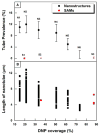Engineered Nanostructures of Haptens Lead to Unexpected Formation of Membrane Nanotubes Connecting Rat Basophilic Leukemia Cells
- PMID: 26057701
- PMCID: PMC4758354
- DOI: 10.1021/acsnano.5b02270
Engineered Nanostructures of Haptens Lead to Unexpected Formation of Membrane Nanotubes Connecting Rat Basophilic Leukemia Cells
Abstract
A recent finding reports that co-stimulation of the high-affinity immunoglobulin E (IgE) receptor (FcεRI) and the chemokine receptor 1 (CCR1) triggered formation of membrane nanotubes among bone-marrow-derived mast cells. The co-stimulation was attained using corresponding ligands: IgE binding antigen and macrophage inflammatory protein 1α (MIP1 α), respectively. However, this approach failed to trigger formation of nanotubes among rat basophilic leukemia (RBL) cells due to the lack of CCR1 on the cell surface (Int. Immunol. 2010, 22 (2), 113-128). RBL cells are frequently used as a model for mast cells and are best known for antibody-mediated activation via FcεRI. This work reports the successful formation of membrane nanotubes among RBLs using only one stimulus, a hapten of 2,4-dinitrophenyl (DNP) molecules, which are presented as nanostructures with our designed spatial arrangements. This observation underlines the significance of the local presentation of ligands in the context of impacting the cellular signaling cascades. In the case of RBL, certain DNP nanostructures suppress antigen-induced degranulation and facilitate the rearrangement of the cytoskeleton to form nanotubes. These results demonstrate an important scientific concept; engineered nanostructures enable cellular signaling cascades, where current technologies encounter great difficulties. More importantly, nanotechnology offers a new platform to selectively activate and/or inhibit desired cellular signaling cascades.
Keywords: atomic force microscopy (AFM); haptens; mast cells; membrane nanotubes; particle lithography; rat basophilic leukemia (RBL) cells; scanning electron microscopy (SEM).
Conflict of interest statement
Figures







Similar articles
-
Engineered nanostructures of antigen provide an effective means for regulating mast cell activation.ACS Nano. 2011 Nov 22;5(11):8672-83. doi: 10.1021/nn202510n. Epub 2011 Nov 7. ACS Nano. 2011. PMID: 21999491 Free PMC article.
-
Hapten-Decorated DNA Nanostructures Decipher the Antigen-Mediated Spatial Organization of Antibodies Involved in Mast Cell Activation.ACS Nano. 2023 Apr 11;17(7):6719-6730. doi: 10.1021/acsnano.2c12647. Epub 2023 Mar 29. ACS Nano. 2023. PMID: 36990450 Free PMC article.
-
Contact-induced redistribution of specific membrane components: local accumulation and development of adhesion.J Cell Biol. 1986 Jun;102(6):2185-96. doi: 10.1083/jcb.102.6.2185. J Cell Biol. 1986. PMID: 2423534 Free PMC article.
-
Rosette Nanotubes Alter IgE-Mediated Degranulation in the Rat Basophilic Leukemia (RBL)-2H3 Cell Line.Toxicol Sci. 2015 Nov;148(1):108-20. doi: 10.1093/toxsci/kfv166. Epub 2015 Jul 29. Toxicol Sci. 2015. PMID: 26224082
-
Review: Diagnostic and therapeutic applications of rat basophilic leukemia cells.Mol Immunol. 2012 Oct;52(3-4):224-8. doi: 10.1016/j.molimm.2012.05.019. Epub 2012 Jun 27. Mol Immunol. 2012. PMID: 22750069 Review.
Cited by
-
Applying Pattern Recognition to High-Resolution Images to Determine Cellular Signaling Status.IEEE Trans Nanobioscience. 2017 Sep;16(6):438-446. doi: 10.1109/TNB.2017.2717871. Epub 2017 Jun 21. IEEE Trans Nanobioscience. 2017. PMID: 28644811 Free PMC article.
-
Direct Observation of Tunneling Nanotubes within Human Mesenchymal Stem Cell Spheroids.J Phys Chem B. 2018 Nov 1;122(43):9920-9926. doi: 10.1021/acs.jpcb.8b07305. Epub 2018 Oct 23. J Phys Chem B. 2018. PMID: 30350968 Free PMC article.
-
Membrane nanotubes are ancient machinery for cell-to-cell communication and transport. Their interference with the immune system.Biol Futur. 2021 Mar;72(1):25-36. doi: 10.1007/s42977-020-00062-0. Epub 2021 Feb 8. Biol Futur. 2021. PMID: 34554502 Free PMC article. Review.
References
-
- Gerdes HH, Bukoreshtliev NV, Barroso JFV. Tunneling Nanotubes: A New Route for the Exchange of Components between Animal Cells. FEBS Lett. 2007;581:2194–2201. - PubMed
-
- Onfelt B, Nedvetzki S, Yanagi K, Davis DM. Cutting Edge: Membrane Nanotubes Connect Immune Cells. J Immunol. 2004;173:1511–1513. - PubMed
-
- Watkins SC, Salter RD. Functional Connectivity between Immune Cells Mediated by Tunneling Nanotubules. Immunity. 2005;23:309–318. - PubMed
Publication types
MeSH terms
Substances
Grants and funding
LinkOut - more resources
Full Text Sources
Other Literature Sources
Miscellaneous

